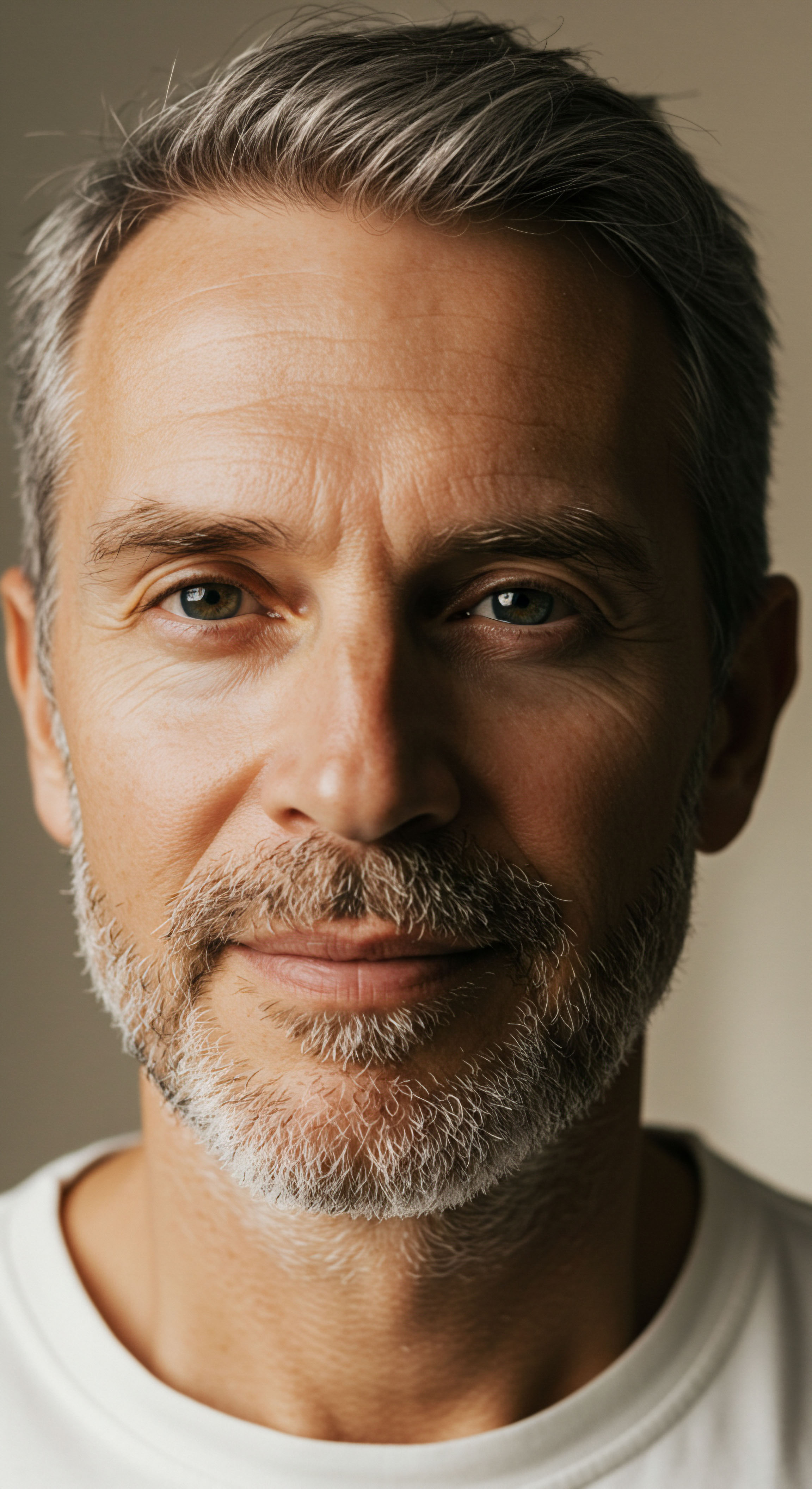

Fundamentals
The journey through hormonal health can feel like navigating a complex landscape, particularly when faced with conditions such as Polycystic Ovary Syndrome (PCOS). Perhaps you have experienced the frustration of irregular menstrual cycles, the unexpected shifts in your body’s metabolic rhythm, or the profound emotional weight that accompanies fertility challenges.
These are not isolated occurrences; they are often interconnected signals from your body, communicating a deeper imbalance within its intricate systems. Understanding these signals marks the initial step toward reclaiming vitality and function.
PCOS is a common endocrine disorder, affecting millions of women during their reproductive years. It is not a singular issue, but rather a constellation of symptoms arising from a complex interplay of hormonal and metabolic disruptions.
Many individuals with PCOS experience a range of manifestations, including irregular or absent ovulation, elevated androgen levels, and the characteristic appearance of multiple small follicles on the ovaries. These factors collectively contribute to the challenges in conceiving naturally, leading many to explore advanced reproductive technologies.
At its core, PCOS involves a disruption in the delicate communication network of the hypothalamic-pituitary-ovarian (HPO) axis. This axis functions like a sophisticated internal thermostat, regulating the production and release of hormones essential for ovulation and menstrual regularity.
In PCOS, this system often encounters interference, leading to an imbalance in key hormones such as luteinizing hormone (LH) and follicle-stimulating hormone (FSH), and an overproduction of androgens. This hormonal environment can impede the proper maturation and release of an egg, a process known as ovulation.
For those seeking to build a family, the irregular ovulation associated with PCOS often presents a significant hurdle. While lifestyle adjustments and conventional ovulation-inducing medications serve as initial strategies, their effectiveness can vary. When these first-line approaches do not yield the desired results, the conversation naturally shifts toward more advanced interventions. This is where advanced reproductive technologies (ART) enter the discussion, offering a structured pathway to assist conception by directly addressing the biological mechanisms of reproduction.
PCOS manifests as a complex endocrine disorder, impacting ovulation and metabolic balance, often leading to fertility challenges.
Advanced reproductive technologies encompass a range of medical procedures designed to facilitate conception by manipulating eggs, sperm, or embryos. These methods aim to overcome specific barriers to fertility, such as irregular ovulation, by providing a more controlled environment for egg development, fertilization, and early embryo growth. The decision to pursue ART is a deeply personal one, often made after careful consideration of individual circumstances, previous treatment responses, and future family goals.


Intermediate
When navigating the complexities of PCOS-related infertility, specific clinical protocols within advanced reproductive technologies offer structured pathways toward conception. These interventions are meticulously designed to circumvent the ovulatory dysfunction characteristic of PCOS, providing a more predictable and controlled environment for reproductive processes. Understanding the ‘how’ and ‘why’ of these therapies is essential for individuals considering such a path.

Ovarian Stimulation Protocols
The initial phase of many ART procedures involves controlled ovarian stimulation (COS), aiming to encourage the ovaries to produce multiple mature eggs in a single cycle. For individuals with PCOS, this phase requires careful management due to their heightened ovarian sensitivity and increased risk of Ovarian Hyperstimulation Syndrome (OHSS). OHSS is a potentially serious complication where the ovaries become overly stimulated, leading to swelling and fluid accumulation.
Commonly employed medications for ovarian stimulation include:
- Clomiphene Citrate ∞ Often a first-line oral medication, it works by blocking estrogen receptors, prompting the pituitary gland to release more FSH and LH, thereby stimulating follicular growth.
- Letrozole ∞ An aromatase inhibitor, letrozole reduces estrogen production, which in turn increases FSH release from the pituitary, promoting ovulation. It is frequently preferred in PCOS due to a lower risk of multiple pregnancies and OHSS compared to clomiphene.
- Gonadotropins ∞ These injectable hormones, containing FSH, LH, or both, directly stimulate the ovaries. They are used when oral medications are ineffective or for more precise control during IVF cycles. Dosing for PCOS patients is typically lower and more carefully titrated to mitigate OHSS risk.
Ovarian stimulation in PCOS requires careful medication selection and dosing to balance egg production with OHSS risk.

In Vitro Fertilization a Core Strategy
In Vitro Fertilization (IVF) stands as a cornerstone of advanced reproductive technologies, particularly for individuals with PCOS who have not achieved pregnancy through other methods. IVF involves several distinct stages, each precisely controlled to maximize the chances of conception.
- Ovarian Stimulation and Monitoring ∞ As discussed, this involves medication to produce multiple follicles. Regular ultrasound scans and blood tests monitor follicle growth and hormone levels, allowing for precise adjustments to medication dosages.
- Egg Retrieval ∞ Once follicles reach an optimal size, a trigger shot (often hCG or a GnRH agonist) is administered to induce final egg maturation. Approximately 36 hours later, eggs are retrieved from the ovaries using a fine needle guided by ultrasound.
- Fertilization ∞ Retrieved eggs are fertilized with sperm in a laboratory setting. This can occur through conventional insemination or Intracytoplasmic Sperm Injection (ICSI), where a single sperm is injected directly into each egg, often used for male factor infertility or to improve fertilization rates.
- Embryo Culture and Transfer ∞ Fertilized eggs, now embryos, are cultured for several days to allow for development. The healthiest embryo or embryos are then transferred into the uterus. For PCOS patients, a frozen embryo transfer (FET) is often recommended over a fresh transfer to reduce OHSS risk, as the body has time to recover from stimulation.
The success rates of IVF for individuals with PCOS are generally favorable, with some clinics reporting live birth rates around 60% for women under 35. While PCOS patients may yield a higher number of eggs during retrieval due to their ovarian reserve, careful management of stimulation protocols is paramount to prevent complications.

Complementary Approaches and Considerations
Beyond the core ART procedures, certain adjunctive therapies and considerations are particularly relevant for individuals with PCOS. These approaches aim to optimize the underlying metabolic and hormonal environment, thereby potentially enhancing ART outcomes.
One significant consideration is the role of insulin resistance, a common feature in PCOS. Medications like metformin, an insulin-sensitizing agent, are sometimes prescribed alongside ART. Metformin can help improve insulin sensitivity, reduce androgen levels, and may decrease the risk of OHSS in certain IVF protocols, particularly long GnRH-agonist protocols. However, its impact on live birth rates in ART cycles remains a subject of ongoing research and varies depending on the specific protocol.
Another area of interest involves myo-inositol and D-chiro-inositol, compounds that play a role in insulin signaling. Supplementation with these inositols, often in a specific ratio, has shown promise in improving insulin sensitivity, regulating menstrual cycles, and potentially enhancing egg quality and ovulation in women with PCOS, which could indirectly support ART success.
The table below summarizes key ART considerations for individuals with PCOS:
| ART Component | PCOS-Specific Consideration | Rationale |
|---|---|---|
| Ovarian Stimulation | Lower gonadotropin doses, careful monitoring | Reduces OHSS risk due to high follicular count. |
| Ovulation Trigger | GnRH agonist trigger often preferred | Minimizes OHSS risk, especially with freeze-all strategy. |
| Embryo Transfer | Frozen embryo transfer (FET) frequently recommended | Allows uterine environment to normalize post-stimulation, reduces OHSS. |
| Adjunctive Medications | Metformin, Myo-inositol/D-chiro-inositol | Addresses insulin resistance, may improve egg quality and reduce OHSS. |
The integration of these advanced reproductive technologies with a deep understanding of PCOS pathophysiology allows for a more tailored and effective approach to fertility challenges. Each step is a deliberate effort to recalibrate the body’s systems, moving closer to the goal of a successful pregnancy.


Academic
A deeper understanding of how advanced reproductive technologies enhance success rates in PCOS requires an exploration of the intricate endocrinological and metabolic underpinnings of the syndrome. PCOS is not merely a reproductive disorder; it represents a complex systemic dysfunction where hormonal axes, metabolic pathways, and cellular signaling are intricately intertwined. This section will analyze the sophisticated mechanisms at play and how ART protocols are precisely adapted to navigate these complexities.

Pathophysiological Foundations of PCOS
The core of PCOS pathophysiology rests upon a triad of interconnected disturbances ∞ hyperandrogenism, ovulatory dysfunction, and often, insulin resistance. While not all individuals exhibit all three, insulin resistance and elevated androgen levels are frequently central to the condition’s progression.
Insulin resistance, a state where the body’s cells do not respond effectively to insulin, leads to compensatory hyperinsulinemia. This elevated insulin directly stimulates ovarian androgen production, particularly from the theca cells, exacerbating hyperandrogenism. Insulin also suppresses the hepatic synthesis of sex hormone-binding globulin (SHBG), which increases the bioavailability of free androgens, further contributing to the clinical manifestations of PCOS. This creates a self-perpetuating cycle where hyperandrogenism can also worsen insulin resistance, particularly in adipose tissue and skeletal muscle.
The chronic anovulation observed in PCOS stems from this disrupted hormonal milieu. Elevated androgens and altered insulin signaling interfere with follicular development, preventing the dominant follicle from maturing and releasing an egg. The ovaries often accumulate numerous small, arrested follicles, giving rise to the “polycystic” morphology.
PCOS involves a complex interplay of hyperandrogenism, ovulatory dysfunction, and insulin resistance, creating a challenging environment for natural conception.

Advanced ART Strategies for PCOS
Given the unique pathophysiological profile of PCOS, ART protocols are meticulously tailored to optimize outcomes while mitigating risks, particularly Ovarian Hyperstimulation Syndrome (OHSS).

GnRH Agonist versus Antagonist Protocols
In controlled ovarian stimulation for IVF, the choice between Gonadotropin-Releasing Hormone (GnRH) agonist and GnRH antagonist protocols holds significant implications for PCOS patients.
- GnRH Agonist Protocols ∞ These protocols initially cause a “flare-up” effect, stimulating FSH and LH release, followed by desensitization and suppression of the pituitary. The “long protocol” has historically been used, providing profound pituitary suppression. While effective for ovarian stimulation, the risk of OHSS can be higher in PCOS patients due to their exaggerated response.
- GnRH Antagonist Protocols ∞ These agents immediately block GnRH receptors in the pituitary, preventing a premature LH surge without the initial flare. This allows for a shorter stimulation period and, crucially, enables the use of a GnRH agonist as a trigger for final oocyte maturation instead of human chorionic gonadotropin (hCG). A GnRH agonist trigger, followed by a “freeze-all” strategy (cryopreservation of all embryos for later transfer), significantly reduces the risk of OHSS in high-risk PCOS patients without compromising cumulative live birth rates. This approach represents a substantial advancement in safety for this population.
Research indicates that while there may not be a significant difference in clinical pregnancy or live birth rates between agonist and antagonist protocols in PCOS, the antagonist protocol offers a safer profile by reducing OHSS incidence.

In Vitro Maturation (IVM)
In Vitro Maturation (IVM) presents an alternative ART approach particularly appealing for PCOS patients. This technique involves retrieving immature oocytes from small antral follicles with minimal or no hormonal stimulation. These immature eggs are then matured in a laboratory setting before fertilization.
The primary advantage of IVM for PCOS patients is the near elimination of OHSS risk, as it bypasses the need for high-dose ovarian stimulation. While IVM success rates have historically been lower than conventional IVF, advancements in culture media and protocols are steadily improving outcomes. IVM may be particularly suitable for individuals with a very high antral follicle count who are at extreme risk of OHSS.

Adjunctive Therapies and Metabolic Optimization
Optimizing the metabolic environment in PCOS patients undergoing ART can significantly influence success.
Metformin, by improving insulin sensitivity, can reduce hyperinsulinemia and hyperandrogenism, which are central to PCOS pathophysiology. While its direct impact on live birth rates in ART cycles remains debated, studies suggest it can reduce OHSS incidence and may improve clinical pregnancy rates in specific long GnRH-agonist protocols. The mechanism involves reducing insulin levels, which in turn can decrease vascular endothelial growth factor (VEGF) production, a key mediator in OHSS development.
The inositols, particularly myo-inositol and D-chiro-inositol, act as secondary messengers in insulin signaling pathways. An imbalance in these inositols is observed in the ovaries of PCOS patients, contributing to insulin resistance and impaired follicular development.
Supplementation, often at a 40:1 ratio of myo-inositol to D-chiro-inositol, has been shown to improve insulin sensitivity, reduce androgen levels, and restore ovulatory function. This metabolic recalibration can lead to improved egg quality and potentially higher pregnancy rates, both naturally and in conjunction with ART.
The table below provides a comparative overview of GnRH protocols in PCOS IVF:
| Protocol Type | Mechanism | PCOS Benefit/Consideration | OHSS Risk |
|---|---|---|---|
| GnRH Agonist (Long) | Initial flare, then sustained pituitary suppression | Effective pituitary desensitization, but higher gonadotropin doses often needed. | Higher, due to prolonged stimulation and hCG trigger. |
| GnRH Antagonist | Immediate pituitary suppression, prevents premature LH surge | Shorter stimulation, allows GnRH agonist trigger for OHSS prevention. | Lower, especially with agonist trigger and freeze-all. |
Understanding these deep biological mechanisms and the tailored application of advanced reproductive technologies provides a comprehensive perspective on enhancing success rates for individuals with PCOS. The ongoing research in areas like GnRH protocols, IVM, and metabolic adjuncts continues to refine these strategies, offering increasingly personalized and effective pathways to parenthood.

Can Genetic Screening Further Improve ART Outcomes in PCOS?
Beyond optimizing ovarian stimulation and metabolic health, the role of Preimplantation Genetic Testing (PGT) in improving ART outcomes for PCOS patients warrants consideration. PGT involves screening embryos for chromosomal abnormalities (PGT-A) or specific genetic disorders (PGT-M/SR) before transfer. While PCOS itself is not directly linked to a higher incidence of aneuploidy in embryos, factors often co-occurring with PCOS, such as advanced maternal age or recurrent pregnancy loss, might indicate a role for PGT.
Some studies suggest that insulin resistance and hyperandrogenism in PCOS could potentially impact oocyte quality at a molecular level, though direct evidence linking PCOS to increased aneuploidy rates is not consistently established.
However, for individuals with PCOS who have experienced multiple failed IVF cycles or recurrent miscarriages, PGT-A could help identify chromosomally normal embryos, thereby potentially improving implantation rates and reducing the risk of early pregnancy loss. This represents a layer of precision medicine, allowing for the selection of embryos with the highest developmental potential.

References
- Palomba, Stefano, et al. “Assisted Reproductive Technologies for Women with Polycystic Ovarian Syndrome.” Reproductive Biology and Endocrinology, vol. 19, no. 1, 2021.
- Advanced Fertility Center of Chicago. “PCOS Treatment for Pregnancy – Fertility Success Rates.” Advanced Fertility Center of Chicago Blog, 2020.
- Chaves, Carolina, et al. “Assisted Reproductive Technology (ART) Success Rate Among Obese And Non-Obese Women, With Infertility Associated With Polycystic Ovary Syndrome (PCOS).” European Congress of Endocrinology 2021, 2021.
- MotherToBe Fertility Centre. “IVF Protocol for PCOS Patients ∞ A Comprehensive Guide.” MotherToBe Fertility Centre Blog, 2024.
- Alife Health. “PCOS and IVF Success Rates.” Alife Health Blog.
- Tso, L. O. et al. “Metformin treatment before and during IVF or ICSI in women with polycystic ovary syndrome.” Cochrane Database of Systematic Reviews, Issue 12, 2020.
- Siristatidis, C. S. “In vitro maturation in subfertile women with polycystic ovarian syndrome undergoing assisted reproduction.” Cochrane Library, 2018.
- Mohammadi, S. et al. “The effect of myo-inositol on fertility rates in poor ovarian responder in women undergoing assisted reproductive technique ∞ a randomized clinical trial.” Reproductive Biology and Endocrinology, vol. 19, no. 1, 2021.
- Lizneva, Daria, et al. “Polycystic ovary syndrome ∞ pathophysiology and therapeutic opportunities.” BMJ Medicine, vol. 2, no. 1, 2023.
- Tso, L. O. et al. “Metformin in women with polycystic ovary syndrome (PCOS) for improving fertility.” Cochrane Database of Systematic Reviews, Issue 12, 2020.
- Unived. “PCOS Fertility ∞ Myo-Inositol & D-Chiro Inositol in a 3.1:6 Ratio for Hormonal Balance.” Unived.
- Verywell Health. “What to Know About Taking Inositol for PCOS.” Verywell Health, 2025.
- Chen, Z. J. et al. “Fresh versus frozen embryos for infertility in the polycystic ovary syndrome.” New England Journal of Medicine, vol. 375, 2016.
- Teede, H. J. et al. “Recommendations from the 2023 International Evidence-based Guideline for the Assessment and Management of Polycystic Ovary Syndrome.” Human Reproduction Update, 2023.
- Tso, L. O. et al. “Metformin treatment before and during IVF or ICSI in women with polycystic ovary syndrome.” Cochrane Database of Systematic Reviews, Issue 12, 2020.

Reflection
Understanding your body’s unique biological systems, particularly when facing the complexities of hormonal health, is a powerful act of self-discovery. The information presented here regarding advanced reproductive technologies and PCOS is not merely a collection of facts; it is a framework for informed decision-making, a guide for navigating your personal health journey. Each individual’s endocrine system operates with distinct nuances, and what works for one may require thoughtful adaptation for another.
Consider this knowledge as a foundational step. It equips you with the vocabulary and concepts to engage more deeply with your healthcare providers, to ask precise questions, and to advocate for a personalized approach that honors your lived experience and your aspirations.
The path to reclaiming vitality and function is rarely linear, yet it is always illuminated by a commitment to understanding your own physiology. Your body possesses an innate intelligence, and with the right support and insights, its capacity for balance and restoration is truly remarkable.
How might a deeper understanding of your hormonal landscape reshape your approach to wellness?



